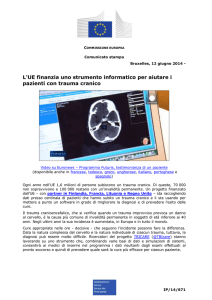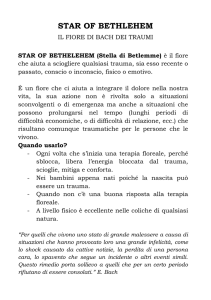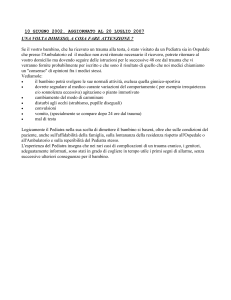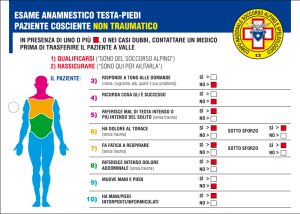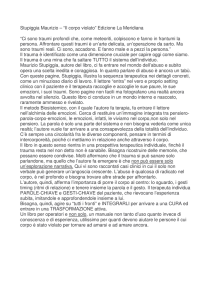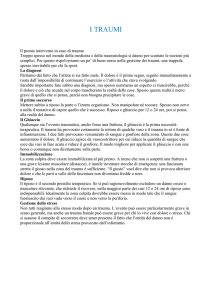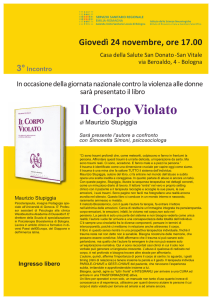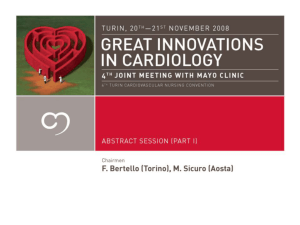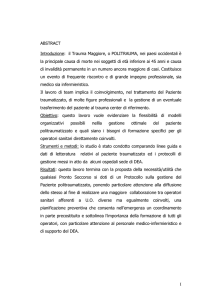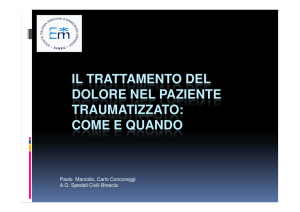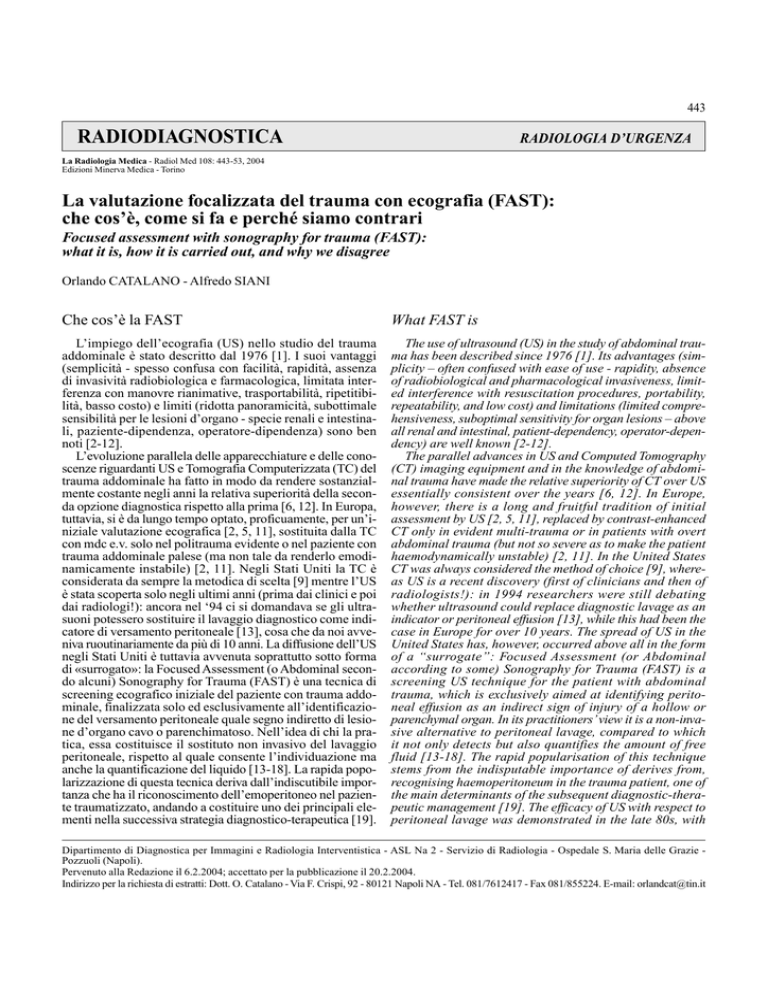
443
RADIODIAGNOSTICA
RADIOLOGIA D’URGENZA
La Radiologia Medica - Radiol Med 108: 443-53, 2004
Edizioni Minerva Medica - Torino
La valutazione focalizzata del trauma con ecografia (FAST):
che cos’è, come si fa e perché siamo contrari
Focused assessment with sonography for trauma (FAST):
what it is, how it is carried out, and why we disagree
Orlando CATALANO - Alfredo SIANI
Che cos’è la FAST
What FAST is
L’impiego dell’ecografia (US) nello studio del trauma
addominale è stato descritto dal 1976 [1]. I suoi vantaggi
(semplicità - spesso confusa con facilità, rapidità, assenza
di invasività radiobiologica e farmacologica, limitata interferenza con manovre rianimative, trasportabilità, ripetitibilità, basso costo) e limiti (ridotta panoramicità, subottimale
sensibilità per le lesioni d’organo - specie renali e intestinali, paziente-dipendenza, operatore-dipendenza) sono ben
noti [2-12].
L’evoluzione parallela delle apparecchiature e delle conoscenze riguardanti US e Tomografia Computerizzata (TC) del
trauma addominale ha fatto in modo da rendere sostanzialmente costante negli anni la relativa superiorità della seconda opzione diagnostica rispetto alla prima [6, 12]. In Europa,
tuttavia, si è da lungo tempo optato, proficuamente, per un’iniziale valutazione ecografica [2, 5, 11], sostituita dalla TC
con mdc e.v. solo nel politrauma evidente o nel paziente con
trauma addominale palese (ma non tale da renderlo emodinamicamente instabile) [2, 11]. Negli Stati Uniti la TC è
considerata da sempre la metodica di scelta [9] mentre l’US
è stata scoperta solo negli ultimi anni (prima dai clinici e poi
dai radiologi!): ancora nel ‘94 ci si domandava se gli ultrasuoni potessero sostituire il lavaggio diagnostico come indicatore di versamento peritoneale [13], cosa che da noi avveniva ruoutinariamente da più di 10 anni. La diffusione dell’US
negli Stati Uniti è tuttavia avvenuta soprattutto sotto forma
di «surrogato»: la Focused Assessment (o Abdominal secondo alcuni) Sonography for Trauma (FAST) è una tecnica di
screening ecografico iniziale del paziente con trauma addominale, finalizzata solo ed esclusivamente all’identificazione del versamento peritoneale quale segno indiretto di lesione d’organo cavo o parenchimatoso. Nell’idea di chi la pratica, essa costituisce il sostituto non invasivo del lavaggio
peritoneale, rispetto al quale consente l’individuazione ma
anche la quantificazione del liquido [13-18]. La rapida popolarizzazione di questa tecnica deriva dall’indiscutibile importanza che ha il riconoscimento dell’emoperitoneo nel paziente traumatizzato, andando a costituire uno dei principali elementi nella successiva strategia diagnostico-terapeutica [19].
The use of ultrasound (US) in the study of abdominal trauma has been described since 1976 [1]. Its advantages (simplicity – often confused with ease of use - rapidity, absence
of radiobiological and pharmacological invasiveness, limited interference with resuscitation procedures, portability,
repeatability, and low cost) and limitations (limited comprehensiveness, suboptimal sensitivity for organ lesions – above
all renal and intestinal, patient-dependency, operator-dependency) are well known [2-12].
The parallel advances in US and Computed Tomography
(CT) imaging equipment and in the knowledge of abdominal trauma have made the relative superiority of CT over US
essentially consistent over the years [6, 12]. In Europe,
however, there is a long and fruitful tradition of initial
assessment by US [2, 5, 11], replaced by contrast-enhanced
CT only in evident multi-trauma or in patients with overt
abdominal trauma (but not so severe as to make the patient
haemodynamically unstable) [2, 11]. In the United States
CT was always considered the method of choice [9], whereas US is a recent discovery (first of clinicians and then of
radiologists!): in 1994 researchers were still debating
whether ultrasound could replace diagnostic lavage as an
indicator or peritoneal effusion [13], while this had been the
case in Europe for over 10 years. The spread of US in the
United States has, however, occurred above all in the form
of a “surrogate”: Focused Assessment (or Abdominal
according to some) Sonography for Trauma (FAST) is a
screening US technique for the patient with abdominal
trauma, which is exclusively aimed at identifying peritoneal effusion as an indirect sign of injury of a hollow or
parenchymal organ. In its practitioners’view it is a non-invasive alternative to peritoneal lavage, compared to which
it not only detects but also quantifies the amount of free
fluid [13-18]. The rapid popularisation of this technique
stems from the indisputable importance of derives from,
recognising haemoperitoneum in the trauma patient, one of
the main determinants of the subsequent diagnostic-therapeutic management [19]. The efficacy of US with respect to
peritoneal lavage was demonstrated in the late 80s, with
Dipartimento di Diagnostica per Immagini e Radiologia Interventistica - ASL Na 2 - Servizio di Radiologia - Ospedale S. Maria delle Grazie Pozzuoli (Napoli).
Pervenuto alla Redazione il 6.2.2004; accettato per la pubblicazione il 20.2.2004.
Indirizzo per la richiesta di estratti: Dott. O. Catalano - Via F. Crispi, 92 - 80121 Napoli NA - Tel. 081/7612417 - Fax 081/855224. E-mail: [email protected]
444
O. Catalano et al: La valutazione focalizzata del trauma con ecografia (FAST)
Sul finire degli anni ‘80 veniva dimostrata la buona efficacia
dell’US rispetto al lavaggio peritoneale e veniva suggerita prima l’integrazione e poi la sostituzione [14, 15, 20, 21]. Da
allora l’«idea FAST», ai nostri occhi poco più che un acronimo, si è estesa in maniera estremamente rapida in Nord
America ove viene considerata sinonimo perfetto di ecografia del trauma [13, 18, 22-27]: nel 1999 il 79% dei centri
regionali per il trauma degli USA praticava questa tecnica
[28]. La diffusione è stata più graduale negli altri paesi, ma
presente comunque sia in Europa che in Asia che in Oceania
[29-34]. La metodica, suggerita sia nei traumi chiusi che in
quelli penetranti [28, 35-37], si è dimostrata costo-efficace
come opzione di studio iniziale del trauma addominale, consentendo una diminuzione del numero di lavaggi peritoneali diagnostici, degli esami TC e delle laparotomie non terapeutiche [32, 35, 38, 39]. Le possibilità tecniche attuali consentono di usufruire anche di apparecchi portatili ormai quasi palmari [36] e di videotelefoni satellitari [40].
suggestions first for integration and then for replacement
[14, 15, 20, 21]. Since then the concept of “FAST”, to us little more than an acronym, has spread very rapidly in North
America where it is considered synonymous to trauma ultrasound [13, 18, 22-27]: in 1999, 79% of regional trauma
centres in the USA used the technique [28]. The spread has
been slower in other countries, but the technique is present
both in Europe and in Australasia [29-34]. The method,
suggested both for blunt trauma and penetrating trauma,
[28, 35-37] proved to be a cost-effective option for the
initial study of abdominal trauma, allowing a reduction in
the number of diagnostic peritoneal lavage procedures, CT
scans and non-therapeutic laparotomies [32, 35, 38, 39].
The current technical possibilities enable to use also portable, now almost palmar, units [36] and satellite videophones [40].
How FAST is carried out
Come si esegue la FAST
Agli albori dell’era FAST si proponeva di ricercare il versamento nel solo recesso epatorenale di Morison, mediante
scansioni longitudinali con paziente in Trendelenburg [23].
Ben presto si è sentita la necessità di esplorare spazi multipli,
declivi e/o vicini alla fonte emorragica. Ambacher [41] e
Rothlin [42] indicano 4 punti da esaminare con scansione longitudinale: epigastrio, ipocondrio destro e sinistro, pelvi.
McGahan [8, 24] ha codificato uno studio in 5 punti: quadrante superiore destro comprensivo della fossa epatorenale,
quadrante superiore sinistro inclusivo della regione perisplenica, doccia paracolica destra e sinistra, pelvi; questa modalità
multifocale è risultata superiore a quella focalizzata sul solo
recesso di Morison (sensibilità 87 e 51% rispettivamente) [43].
Alcuni Autori [8, 37, 44] hanno poi incluso nei 5 spazi il pericardio, oltre a spazio subfrenico destro e sinistro, spazio sottoepatico e pelvi. Altri Autori [18, 45] parlano di esplorazione in sei punti, con vista sottoxifoidea, sovrapubica, del quadrante superiore destro e sinistro dell’addome e del quadrante destro e sinistro della pelvi. Altri ancora [46, 47] valutano
7 regioni per l’individuazione di versamento (quadranti superiori, logge renali, docce paracoliche e pelvi): la ricerca del liquido anche nel retroperitoneo indica l’intenzione di non limitare lo studio al solo emoperitoneo. In ogni caso, la tendenza
generale è verso la standardizzazione della metodica, con definizione di un numero fisso di proiezioni costanti, tese esclusivamente a esplorare i recessi peritoneali declivi. L’indagine
può essere così eseguita in 1-5 minuti [17, 19, 23, 28, 48].
Alcuni gruppi radiologici, anche negli USA [8, 17, 34, 47,
49-52], hanno progressivamente optato pur uno studio più
completo con un’esplorazione in qualche modo comprensiva
dei parenchimi, sebbene ancora ben lontana dalla tecnica «a pieno potenziale» di cui diremo in seguito. La maggioranza della letteratura non radiologica utilizza la FAST nuda e cruda.
Sul piano metodologico, la necessità di esplorare tra le sedi
costanti il pericardio ci lascia personalmente perplessi: se è vero
che sempre nello studio dell’addome di urgenza è opportuno
anche angolare la sonda in sede sottoxifoidea e ricercare un versamento pericardico, è anche vero che tra gli aspetti costanti
sarebbe forse meglio ricercare, da ambo i lati, il versamento
At the beginning of the FAST era, the examination was
directed at searching for effusion in the hepatorenal fossa of
Morison by using longitudinal scans with the patient in
Trendelenburg position [23]. Soon the need arose to image
multiple spaces, deep and/or close to the source of the bleed.
Ambacher [41] and Rothlin [42] indicate four regions to be
examined with longitudinal US scans: epigastrium, right
and left upper quadrants, pelvis. McGahan [8, 24] codified
a five-point study: right upper quadrant including the hepatorenal fossa, left upper quadrant including the perisplenic region, right and left paracolic gutters, pelvis; this multifocal study proved better than the one focused only on the fossa of Morison (sensitivity 87% and 51%, respectively) [43].
Some authors [8, 37, 44] extended this five-point study to
include the pericardium, the right and left subphrenic spaces, the subhepatic space and the pelvis. Some [18, 45] adopt
a six-point exploration including a subxiphoid and suprapubic view of the upper right and left abdominal quadrants
and of the right and left pelvic quadrants. Others still [46, 47]
examine seven regions for fluid (both upper quadrants, both
renal fossae, both paracolic gutters and pelvis): extending the
search for fluid to the retroperitoneum indicates an intention not to limit the study to haemoperitoneum alone. At any
rate, the general tendency is to standardise the method, with
definition of a fixed number of constant views aimed exclusively at exploring the deep peritoneal recesses. The examination can thus be performed in 1-5 minutes [17, 19, 23,
28, 48].
Some radiological groups, even in the USA [8, 17, 34, 47,
49-52], have opted for a more complete work-up by extending the study to the parenchymas, although this is still far from
the “full potential” technique described below. Most of the
radiology literature utilises the FAST technique as it stands.
Methodologically, we have some doubts about the need to
include the pericardium among the sites to be routinely
explored: while it is true that in emergency abdominal sonography a subxiphoid view should also always be incorporated to screen for pericardial effusion, it is also true that it
might be more useful to routinely screen for pleural effusion
bilaterally, a finding that is definitely more frequent than
O. Catalano et al: La valutazione focalizzata del trauma con ecografia (FAST)
445
pleurico, reperto certamente più frequente dell’emopericardio e possibile spia di un trauma sia addominale che toracico.
Tra l’altro, un lieve scollamento della sierosa pericardica è
presente in molti soggetti, specie di età medio-avanzata.
Anche la necessità di distendere la vescica con riempimento
retrogrado ci appare poco convincente: il soggetto con trauma
ha generalmente, nella nostra esperienza, una distensione del
viscere adeguata per la ricerca di liquido ed anzi una sovradistensione vescicale iatrogena può ostacolare il riconoscimento del versamento. Se il paziente è già portatore di catetere e
vi è il dubbio di un lieve versamento pelvico il riempimento
retrogrado del viscere può essere talora utile ma effettuarlo
di routine e preventivamente [18] ci sembra eccessivo.
haemopericardium and a possible sign of abdominothoracic trauma. Moreover, a slight detachment of the pericardial
serosa is present in many subjects, especially in middle-toadvanced age.
Even the need for bladder distension by retrograde filling
appears poorly convincing: in our experience the trauma
subject generally has adequate bladder distension to search
for fluid and induced bladder overdistension may hinder
recognition of the fluid. If the patient has a catheter and a
small pelvic effusion is suspected, retrograde bladder filling may sometimes prove useful, but practising it pre-emptively and routinely [18] appears excessive.
Chi esegue la FAST
Who performs FAST
In Europa l’ecografia del trauma è stata sinora effettuata
essenzialmente da radiologi, sia nel Servizio di Diagnostica
che, eventualmente, nel Pronto Soccorso [53]. Negli USA essa
è praticata di solito da tecnici sonografisti, con la supervisione
diretta o indiretta del radiologo [17, 18, 45-47, 49, 52]. Intesa
come screening iniziale del soggetto traumatizzato, la FAST ha
avuto tuttavia rapida diffusione anche tra rianimatori e chirurghi d’urgenza e ciò soprattutto presso strutture dove i radiologi non sono presenti hh. 24/gg. 7: nel ‘99 la tecnica era eseguita
da radiologi nel 35% dei centri USA ove era praticata, da chirurghi d’urgenza nel 39%, da chirurghi e rianimatori nel 21%,
da rianimatori nel 5% [28]. Alcuni clinici si limitano a interpretare le immagini ottenute da tecnici [54] ma la maggioranza sembra eseguire personalmente l’indagine [28, 32, 35, 38].
In molti paesi si vanno definendo i criteri per la certificazione
professionale e addestramento per rianimatori e chirurghi [29].
La sensibilità per identificazione e quantificazione del
liquido dipende dall’esperienza dell’operatore [33]: con un
training minimo, moderato o ampio la sensibilità è rispettivamente del 45, 87 e 100% per versamento <1000 ml e rispettivamente del 38, 63 e 90% per versamento <250 ml [55]. Una
curva di apprendimento è assente in uno studio [56] mentre
inizia ad appiattirsi dopo 30-100 esami in un altro [55]; in una
casistica raccolta in 19 mesi [45] il 67% dei falsi negativi si
verificava nei primi 3. Alcuni Autori [26] hanno indicato la
necessità di almeno 200 esami supervisionati per acquisire una
sufficiente capacità diagnostica, altri ritengono che ne sia
sufficiente una decina [56].
In due studi [51, 57] i chirurghi avevano una capacità interpretativa della FAST sovrapponibile a quella dei radiologi.
Eseguita da residents di chirurgia al 3° anno la FAST ha dimostrato sensibilità del 47%, specificità del 96%, valore predittivo positivo dell’89%, valore predittivo negativo del 72% e
accuratezza dell’82% [31]; effettuata in bambini da chirurghi
residenti o attendenti essa è risultata tecnicamente adeguata
nel 98% dei soggetti eleggibili, con sensibilità dell’80% e
specificità del 100% [44]. Si tratta di valori non sempre accettabili ma che comunque tenderanno a migliorare con la diffusione della metodica e dei protocolli di training specifico.
Alcuni lavori [18] hanno dimostrato come il Servizio di
Radiologia possa coprire il servizio di FAST per il Pronto
Soccorso in maniera agevole e valida sul piano dei costi (sebbene non è detto che tali considerazioni siano estendibili a
sistemi e strutture sanitarie differenti). Non è tuttavia l’aspet-
In Europe trauma sonography has been mainly performed
by radiologists, both at the Diagnostic Imaging Department
and in the Emergency Department [53]. In the USA it is usually practised by sonographers, under the direct or indirect
supervision of a radiologist [17, 18, 45-47, 49, 52]. Intended
as a screening examination of trauma subjects, FAST has,
however, also had rapid diffusion among intensivists and
emergency surgeons and this, mainly in centres without 24/7
radiologist coverage: in ’99 the technique was performed
by radiologists in 35% of USA centres where it was practised, by emergency surgeons in 39%, by surgeons and intensivists in 21%, by intensivists in 5% [28]. Some clinicians limit themselves to interpreting the images obtained by the ultrasound technologists [54] but the majority seem to perform the
examinations themselves [28, 32, 35, 38]. In many countries
criteria are being defined for the credentialling and training
of intensivists and surgeons [29].
Sensitivity for the detection and quantification of free fluid
depends on the operator’s experience [33]: with minimal,
moderate or extensive training, sensitivity is 45%, 87% and
100%, respectively, for effusions <1000 ml and 38%, 63% and
90%, respectively, for effusions <250 ml [55]. There was no
learning curve in one study [56] whereas it tended to level off
after 30-100 examinations in another [55]; in a series collected over 19 months [45] 67% of the false negative findings
occurred in the first three months. Some authors [26] have
indicated the need for at least 200 supervised examinations
to acquire sufficient diagnostic skill, others consider about
ten to be enough [56].
In two studies [51, 57] surgeons performed as well as
radiologists in interpreting the results of FAST. When done by
3rd year surgical residents, FAST had a sensitivity of 47%,
specificity of 96%, positive predictive value of 89%, negative
predictive value of 72% and accuracy of 82% [31]; performed in children by resident or attending surgeons it proved
to be technically adequate in 98% of eligible subjects, with
a sensitivity of 80% and specificity of 100% [44]. The values
are not always acceptable but they will tend to improve as the
method spreads and specific training protocols are established.
Some authors [18] have shown that the Radiology
Department can cover the FAST service for the Emergency
Department easily and validly in terms of costs (but these considerations may not be applicable to different healthcare
446
O. Catalano et al: La valutazione focalizzata del trauma con ecografia (FAST)
to economico a preoccuparci quanto piuttosto il fatto che mani
mediamente poco esperte, o comunque mediamente meno
esperte di quelle dei radiologi d’urgenza, siano deputate a svolgere una funzione così delicata quale quella dell’esplorazione
ecografica di un addome traumatizzato (o di un addome acuto
non traumatico), spesso basata su rilievi impercettibili o su
pure sensazioni. Se poi tanta letteratura americana ritiene che
l’US abbia paragonabile efficacia se praticata dal radiologo e
dal chirurgo (che abbia fatto un po’di training) può solo significare, a nostro avviso, che le capacità ecografiche dei radiologi
d’oltreoceano (dirette o mediate da tecnici sonografisti) sono
significativamente inferiori a quelle dei colleghi europei.
Come si interpreta la FAST
La presenza di un versamento peritoneale in un soggetto
con trauma è generalmente ritenuto indicativo di emoperitoneo, sebbene possa anche essere dovuto a bile, urina o
liquido intestinale, possa essere misto o possa essere dovuto a un’ascite preesistente [17].
La distribuzione del liquido privilegia le sedi declivi, in particolare lo spazio sottoepatico posteriore e quello pelvico
mediano, sebbene casistiche TC [58] abbiano dimostrato la
frequenza dell’interessamento, anche isolato, dello spazio
subfrenico anteriore destro (meno accessibile all’US rispetto agli altri, specie nel paziente che non è in grado di inspirare profondamente). La massima probabilità di individuare
il liquido corrisponde anche alla sede dell’emorragia [59]. La
conoscenza dei patterns di distribuzione può aiutare nella
ricerca dell’organo lesionato: nell’adulto un versamento nel
quadrante superiore sinistro, in entrambi i quadranti superiori
o diffuso orienta verso un’origine splenica, uno nel quadrante superiore destro oppure in questo e nei recessi sottomesocolici suggerisce un sanguinamento epatico; le lesioni
intestinali hanno una distribuzione casuale del liquido e quelle extraperitoneali mostrano un accumulo locale dell’eventuale versamento [46]. Nel bambino la sede più frequente di
accumulo, e quella più cospicua quantitativamente, sembra
essere in ogni caso la pelvi; il volume medio di liquido è
inoltre maggiore nelle lesioni spleniche che in quelle epatiche [60]. Nelle donne in età fertile un versamento isolato
nello spazio di Douglas è quasi sempre fisiologico e la necessità di monitoraggio dipende da caso a caso [61].
Entro determinati limiti, l’entità dell’emoperitoneo si correla con la probabilità di lesione d’organo significativa e
quindi, ancora entro determinati limiti, con la gravità della
lesione parenchimale e la prognosi [60, 62-65]. In particolare,
la probabilità di successo del trattamento conservativo del
trauma epatico e splenico sembra correlarsi sia nell’adulto che
nel bambino con l’entità dell’emoperitoneo, oltre che con
fattori clinici e laboratoristici [62-68]. Conseguentemente, si
è sviluppata la necessità di quantificare il versamento. Sono
stati proposti diversi sistemi di scoring: la somma aritmetica del numero di recessi peritoneali positivi [65], la somma
aritmetica del numero di recessi peritoneali con falde >2 mm
[67], la somma dello spessore in cm delle raccolte liquide nei
5 spazi esplorati [68], l’altezza in cm della raccolta liquida più
ampia + il numero degli altri spazi peritoneali positivi [17, 62,
63, 66]. Premesso che ai chirurghi interessa poco sapere
quanto è il punteggio registrato se tale dato non viene poi
systems and institutions). Our main concern is not, however, the economic issue but the fact that health professionals
with on average little experience, or at any rate less experience than emergency radiologists, should be allowed to carry out such a delicate function as the sonographic exploration of a traumatised abdomen (or of an acute, non traumatised abdomen), often relying on barely perceivable findings
or mere sensations. In addition, if so many North American
reports believe US to have comparable efficacy whether performed by a radiologist or by a surgeon (duly trained) it can
only mean, in our opinion, that the sonographic skills of
American radiologists (direct or mediated by ultrasound
technologists) are significantly inferior to those of their
European counterparts.
How FAST is interpreted
The presence of peritoneal free fluid in a trauma subject
usually indicates haemoperitoneum, although it may also
represent bile, urine or bowel contents, be mixed or be due
to pre-existing ascites [17].
The fluid tends to distribute in the most dependent
regions, in particular in the posterior subhepatic space
and the median pelvic space, even though CT series [58]
have also demonstrated isolated involvement of the right
anterior subphrenic space (less amenable to US than other techniques especially in subjects unable to breathe deeply). The likelihood of detecting free fluid also depends on
the site of the bleed [59]. Knowledge of the distribution
patterns may help in the search of the injured organs: in the
adult, fluid in the left upper quadrant, in both upper quadrants or diffusely distributed will suggest splenic injury,
whereas fluid in the right upper quadrant or the right upper
quadrant and lower recesses suggests a hepatic bleed;
fluid accumulation is random in enteric injuries whereas it
is absent or locally distributed in extraperitoneal injuries
[46]. In children, the most common site of fluid accumulation, and where the quantity of free fluid is greatest, is the
pelvis; the mean volume of fluid is greater in splenic injury than in hepatic injury [60]. In women of reproductive age
isolated fluid in the pouch of Douglas is almost always
normal and the need for monitoring will depend on the
individual patient [61].
Within given limits, the extent of haemoperitoneum is correlated with the likelihood of severe organ injury and therefore, still within these limits, with the seriousness of parenchymal injury and outcome [60, 62-65]. In particular, the
likelihood of success of conservative treatment of a splenic
or hepatic injury appears to correlate, in both adults and
children, with the extent of haemoperitoneum, as well as
with clinical and laboratory findings [62-68]. Consequently,
a need has arisen to quantify the effusion. Different scoring
systems have been proposed: the sum of the number of positive peritoneal recesses [65], the sum of peritoneal recesses with collections >2 mm [67], the sum of the depth in centimetres of the fluid collections in the 5 spaces inspected
[68], the height in centimetres of the largest fluid collection
added to the number of other positive peritoneal spaces [17,
O. Catalano et al: La valutazione focalizzata del trauma con ecografia (FAST)
tradotto in millilitri, noi dissentiamo soprattutto dalla condotta
di optare per l’intervento chirurgico basandosi solo su di uno
score dell’emoperitoneo elevato alla FAST [17, 62, 63, 65, 67,
68] poiché questa ci sembra una semplificazione eccessiva di
un’analisi decisionale complessa e da fare caso per caso.
La sensibilità degli ultrasuoni nell’identificare il versamento peritoneale è comunemente ritenuta elevata (fig. 1),
analoga se non superiore a quella della TC con mdc e.v.
(sebbene in una casistica essa fosse leggermente inferiore,
anche quando l’US veniva ripetuta alla luce dei dati TC
[12]). In casistiche cliniche [4, 18, 23, 24] si è rilevata sensibilità del 63-98%, specificità del 94-100%, valore predittivo positivo dell’86-100%, valore predittivo negativo dell’8595% e accuratezza dell’85-95%. Valutando sperimentalmente donne sottoposte a isterosalpingografia (circa 10 ml
di mdc) e soggetti esaminati con erniografia (circa 50 ml di
mdc) si è osservata una sensibilità degli ultrasuoni del 71%
nel primo gruppo e del 100% nel secondo [59]. Esaminando
sperimentalmente la regione pelvica di soggetti sottoposti a
lavaggio peritoneale diagnostico si è rilevata la necessità di
una modesta quantità di liquido (volume mediano 100 ml)
perché l’US si positivizzasse [69]. In proposito vi è tuttavia
un articolo controcorrente [70]: studiando con US il recesso di Morison durante l’infusione di liquido per lavaggio
peritoneale diagnostico (in Trendelenburg) solo il 10% dei
partecipanti (clinici attendenti e residenti di medicina d’urgenza, chirurgia e radiologia) riconosceva un volume <400
ml e il volume medio identificato era di ben 619 ml. Premesso
che non è detto che le conclusioni ottenute sperimentalmente siano applicabili nel trauma, ove la distribuzione del
liquido può seguire regole differenti, i risultati del suddetto
lavoro sono quantomeno non in linea con la comune esperienza quotidiana, secondo la quale l’US identifica piccolissime falde di liquido.
Considerazioni personali sulla tecnica FAST
Che dinanzi a un paziente emodinamicamente instabile, o
comunque in condizioni francamente gravi, l’US dovesse
essere eseguita celermente e focalizzarsi soprattutto sulla
ricerca dell’emoperitoneo, al fine di definire l’immediata
necessità di una laparotomia e la priorità terapeutica in particolare in soggetti con lesioni multidistrettuali (intra- ed
extraddominali) [15, 68], è cosa ovvia per tutti i radiologi
italiani. Che però questo potesse divenire una tecnica diagnostica autonoma, intesa come rapida (di nome e di fatto)
«spazzolata» dell’addome del traumatizzato, e addirittura
potesse fungere da «cavallo di Troia» per l’inizio di un’attività ecografica autonoma in Pronto Soccorso, questo non lo
avremmo mai pensato.
Il problema sostanziale, e insormontabile, della FAST
nasce dinanzi alla larga maggioranza dei pazienti con sospetto trauma addominale, che sono emodinamicamente stabili
e che quindi possono essere valutati con sufficiente accuratezza: in questi pazienti la sola dimostrazione della presenza o dell’assenza di liquido peritoneale non è sufficiente.
Sebbene la TC con mdc e.v. sia unanimemente ritenuta la
metodica più accurata nello studio del trauma addominale, non
è evidentemente possibile sottoporre a quest’indagine la tota-
447
Fig. 1. — Scansione ecografica trasversale che dimostra una minima falda liquida (freccia) intorno all’apice della grande ala epatica. Simili reperti possono sfuggire ad uno studio TC non particolarmente collimato e pertanto questa metodica non può essere utilizzata come standard nel giudicare l’accuratezza dell’US.
Transaxial sonographic scan showing minimal fluid collection (arrow)
around right hepatic lobe apex. These changes may be overlooked by normal-thickness CT scans. Hence, CT cannot be used as a reference standard
to assess US effectiveness.
62, 63, 66]. Besides the fact that a score that is not translated into millilitres is of little help to surgeons, we disagree
above all with the practice of basing the decision to opt for
surgery exclusively on a elevated haemoperitoneum score
at FAST imaging [17, 62, 63, 65, 67, 68] as this seems to be
an oversimplification of a complex decision analysis that
should be done on a case-by-case basis.
The sensitivity of ultrasound in detecting peritoneal effusion is commonly believed to be high (fig. 1), and similar if
not superior to contrast-enhanced CT (although in one study
it was slightly lower, even when US was repeated in the light
of the CT findings [12]). Clinical case series [4, 18, 23, 24]
demonstrated a sensitivity of 63-98%, specificity of 94-100%,
positive predictive value of 86-100%, negative predictive
value of 85-95% and accuracy of 85-95%. An experimental
study comparing women undergoing hysterosalpyngography (about 10 ml of contrast) and subjects examined by herniography (about 50 ml of contrast) showed a sensitivity to
ultrasound of 71% in the first group and of 100% in the second [59]. An experimental examination of the pelvic region
in subjects undergoing diagnostic peritoneal lavage revealed
that a modest quantity of fluid (median volume 100 ml) had
to be present for US to become positive [69]. On this subject,
there is a discordant study [70]: studying the Morison pouch
by US during the infusion of fluid for diagnostic peritoneal
lavage (in Trendelenburg) only 10% of participants (attending clinicians and emergency medicine, surgery and radiol-
448
O. Catalano et al: La valutazione focalizzata del trauma con ecografia (FAST)
lità dei pazienti, inclusi quelli studiati per motivi essenzialmente medico-legali o comunque con bassa (ma non nulla!)
probabilità di lesione addominale. È quindi necessario un
«filtro» diagnostico pre-TC, che per ovvi motivi non può
essere né quello clinico-laboratoristico né quello del osservazione temporale né quello del lavaggio peritoneale diagnostico ma che ad oggi può solo basarsi sull’impiego, però
a pieno potenziale, degli ultrasuoni [7l].
La FAST ha dimostrato sensibilità del 57-81%, specificità
del 98-99%, valore predittivo positivo dell’80-86%, valore
predittivo negativo del 96-97% e accuratezza del 90-96%
nell’identificare un trauma addominale attraverso il riconoscimento del liquido [18, 28, 36, 48]. Essa risulta falsamente negativa nel 17-29% dei casi rispetto alla TC [72-74]. Nei
bambini, rispetto alla TC, la sensibilità è risultata del 3059%, la specificità del 79-100%, il valore predittivo negativo del 75-82%, l’accuratezza del 76-91% [48, 52, 75, 76] e
detti risultati fanno propendere alcuni [48] contro l’uso della FAST nel trauma pediatrico.
Il rischio di falsa negatività della FAST è legato a errori
interpretativi, con versamento peritoneale presente ma non
riconosciuto, e soprattutto ai casi di lesione parenchimale
anche rilevante non associata almeno inizialmente con emoperitoneo [12, 52, 72, 74]. Nelle casistiche TC una lesione
d’organo, parenchimale o cavo, senza versamento peritoneale associato è presente nel 29-34% dei casi totali, nell’11%
dei traumi epatici e nel 12% di quelli splenici (sebbene sia
verosimile che una parte di questi casi avesse in realtà falsa
negatività della TC per minime falde liquide) [12, 73, 74,
77]. Il 25-37% dei bambini non ha versamento associato alle
lesioni traumatiche [79, 80]. In casistiche ecografiche il 12%
delle lesioni spleniche isolate, il 5% di quelle epatiche totali e il 15% di quelle epatiche isolate non mostra versamento
peritoneale [25, 46]. I casi indeterminati, dovuti soprattutto
ad obesità, rappresentano nelle casistiche americane il 2,56,7% [80, 81] (sebbene sia per noi difficile comprendere
come, anche nei pazienti più corpulenti, non fosse possibile
dire se vi era liquido libero in addome oppure no!).
L’assunto [81] che una lesione senza versamento è di
solito di modesta entità e quindi, anche se misdiagnosticata, non tale da compromettere una gestione conservativa del
paziente non risulta sempre fondato: nel 10-17% dei casi
di lesione viscerale senza versamento associato, il quadro è
di entità tale da richiedere un trattamento invasivo, sia esso
chirurgico o radiointerventistico [12, 74]. Per il vero, nella
nostra realtà il numero di casi di lesione d’organo senza
versamento e di lesione d’organo senza versamento di gravità tale da richiedere un trattamento è sensibilmente inferiore rispetto ai dati della letteratura. In ogni caso, da tali dati
emerge la necessità di un’esplorazione US anche degli organi, di modo che il sospetto o la diagnosi di lesione traumatica derivi dall’individuazione del versamento e/o delle alterazioni parenchimali [49].
Necessità di un’ecografia «a pieno potenziale»
In alcune recenti messe a punto sull’imaging del trauma
addominale [19, 41, 82] la FAST costituisce la sola e unica
modalità ecografica considerata e addirittura si arriva a rac-
ogy residents) identified a volume <400 ml and the mean
volume identified was 619 ml. Besides the fact that these
experimental results may not be applicable to the trauma
setting where fluid distribution may follow different rules,
the results of this paper are in conflict with common, day-today experience, which shows that US is capable of detecting
very small fluid collections.
Personal remarks on the FAST technique
The fact that haemodynamically unstable patients or at
any rate badly injured patients should undergo rapid US
screening for haemoperitoneum to establish immediately
the need for laparotomy and the treatment priorities, in particular in subjects with multi-organ injuries (intra- and
extrabdominal) [15, 68], is well known to all Italian radiologists. But that this could become an independent diagnostic technique, intended as a fast (by name and nature) “sweep” of the traumatised abdomen, and even serve a
“Trojan horse ” for the start of an independent sonographic activity in the Emergency Department is something we
would never have imagined.
The main, insurmountable, problem of FAST refers to the
large majority of patients with suspected abdominal trauma, who are haemodynamically stable and can therefore be
evaluated with adequate accuracy: in these patients the mere
demonstration of the presence or absence of peritoneal fluid
is not sufficient. Although contrast-enhanced CT is universally recognised as the most accurate method in the study of
abdominal trauma, it is evidently impossible to perform CT
on all patients, including those being studied for medicolegal purposes or at any rate with a low (but not zero!) probability of abdominal injury. A pre-CT diagnostic “filtre” is
therefore needed, which for obvious reasons cannot rely on
clinical-laboratory studies, patient observation or diagnostic peritoneal lavage but can only be based on ultrasound,
used at its full potential [7l].
FAST has demonstrated a sensitivity of 57-81%, specificity of 98-99%, positive predictive value of 80-86%, negative
predictive value of 96-97% and an accuracy of 90-96% in
identifying an abdominal trauma by detecting the presence
of free fluid [18, 28, 36, 48]. It has false negative results in
17-29% of cases compared to CT [72-74]. In children, compared to CT, it has a sensitivity of 30-59%, specificity of 79100%, negative predictive value of 75-82%, and accuracy of
76-91% [48, 52, 75, 76], results which have led some authors
[48] to conclude against the use of FAST for trauma in children.
The risk of false negative results is related to interpretation errors, where peritoneal fluid is present but undetected,
and above all to cases of even severe parenchymal injury at
least initially not associated with haemoperitoneum [12, 52,
72, 74]. In CT series, injured parenchymal or hollow organs
without peritoneal effusion have been reported in 29-34% of
total cases, in 11% of hepatic injuries and in 12% of splenic injuries (although some of these cases were likely false
negative at CT for minimal fluid collections) [12, 73, 74,
77]. No effusion is associated to traumatic injuries in 2537% of children [79, 80]. In US series, 12% of isolated splen-
449
O. Catalano et al: La valutazione focalizzata del trauma con ecografia (FAST)
Fig. 2. — A) Scansione con sonda
addominale dimostrante un tenue focolaio lacerativo splenico (freccia). B)
La scansione con sonda ad alta frequenza evidenzia in maniera molto
più accurata la lesione (freccia).
A) US scan with abdominal probe
detecting subtle lacerative changes of
the spleen (arrow). B) High-resolution images demonstrate the injury
much more clearly (arrow).
comandare come l’ecografia del trauma vada eseguita «senza l’inutile esplorazione dettagliata degli organi» [19].
L’ecografia completa, eseguita da clinico o radiologo, ha
dimostrato sensibilità del 41-95%, specificità del 94-100%,
accuratezza del 95-99%, valore predittivo positivo del 6187%, valore predittivo negativo del 62-99% nel riconoscere lesioni parenchimali [12, 34, 49-51, 53]. Nel bambino
sono stati riportati dati mediamente meno confortanti soprattutto in termini di sensibilità: sensibilità 56-89%, specificità
71-100%, valore predittivo positivo 82-100%, valore predittivo negativo 82-96%, accuratezza 92-94% [44, 52, 75,
83]. I falsi negativi totali dell’US completa risultano in una
casistica il 28% dei pazienti [12] mentre in un’altra i falsi
negativi epatici sono il 28% dei casi [25]. In due serie [49,
50] l’11-33% dei falsi negativi dell’US completa richiedeva alla fine una laparotomia mentre in un’altra casistica la falsa negatività dell’US non comportava conseguenze significative in alcun soggetto [24]. Da alcuni punti di vista i più
pessimistici tra questi dati, che peraltro non concordano con
l’esperienza personale, potrebbero portare all’abbandono
dell’US del trauma (sia come FAST che soprattutto come studio completo) [12, 77, 82]. Dall’altro lato, tuttavia, i risultati non sempre ottimali riportati nella letteratura dovrebbero
condurre al rafforzamento massimale della tecnica ecografica, seppur nella coscienza dei limiti della metodica e della sua natura di opzione «iniziale» (seppur spesso sufficiente) [34, 52, 53].
Esiste un ampio spettro di accorgimenti tecnico-metodologici che sfugge completamente alla messe di lavori pubblicati sull’argomento, siano essi di matrice clinica o radiologica. Le sonde superficiali (7,5 MHz) consentono per esempio, quantomeno nel bambino e nel soggetto magro, di visualizzare meglio le lesioni parenchimali rispetto alle sonde
ic injuries, 5% of total hepatic injuries and 15% of isolated
hepatic injuries show no peritoneal effusion [25, 46].
Indeterminate cases, mainly due to obesity, account for 2.56.7% in North American series [80, 81] (even though we
find it difficult to understand why, even in the heavier patients,
it was impossible to discriminate whether or not there was free
fluid in the abdomen!).
The assumption [81] that a lesion without effusion is usually modest and therefore, even if missed, not so severe as to
compromise conservative management is not always well
founded: in 10-17% of organ injuries without associated
effusion, the clinical situation does indeed require invasive
treatment, whether surgical or interventional [12, 74]. In
fact, in our experience the number of organ lesions without
effusions or with only minimal effusion not requiring treatment is considerably lower than reported in the literature. At
any rate, these data indicate the need for a US exploration
extended to the organs, so as to base the suspicion or diagnosis of traumatic injury on detection of the effusion and/or
of parenchymal alterations [49].
The need for “full potential” sonography
In some recent reviews of abdominal trauma imaging [19,
41, 82] FAST represents the only ultrasound modality considered, and some authors even recommend performing trauma
sonography without useless detailed exploration of organs
[19].
A complete US study, carried out by a clinician or radiologist, demonstrated a sensitivity of 41-95%, specificity of
94-100%, accuracy of 95-99%, positive predictive value of
450
O. Catalano et al: La valutazione focalizzata del trauma con ecografia (FAST)
Fig. 3. — Ampio focolaio lacerativo mesosplenico (frecce) manifestantesi
come difetto nell’angioarchitettura parenchimale con power-Doppler.
Large lacerative area at spleen middle third (arrow) seen as a defect in
power-Doppler parenchymal angioarchitecture.
internistiche [84] e andrebbero utilizzate in tutti i soggetti
accessibili, sia per ricercare minime falde liquide intorno
all’apice epatico o al polo splenico inferiore che per identificare lesioni d’organo nelle porzioni più superficiali di fegato, rene e milza (questi ultimi due, in alcuni casi, visualizzabili
per intero) (fig. 2). Alcuni reperti sinora poco ricercati con
l’US, come il pneumoperitoneo [85] e il pneumotorace [9],
possono essere identificati ecograficamente, con opportune
accortezze metodologiche e semeiologiche. L’imaging armonico tissutale, disponibile ormai in tutti gli ecografi recenti,
offre una risoluzione superiore rispetto a quella in modalità
fondamentale, a parità di profondità, e ciò è risultato potenzialmente utile nella valutazione dei parenchimi in soggetti
traumatizzati, specie se obesi [86]. L’utilizzo del powerDoppler, sia basale che con impiego di mdc ecoamplificatori [87], può essere di grosso ausilio (sebbene è inverosimile
che ciò renda la metodica paragonabile in tutto alla TC come
segnalato in letteratura [87]). Alcuni casi clamorosi di falsa
negatività dell’US descritti in letteratura, come la devascolarizzazione completa di un rene [10], sarebbero ad esempio
stati evitati con estrema facilità «accendendo» il powerDoppler: noi cerchiamo di percepire un difetto della mappa
vascolare parenchimale al power-Doppler, a livello renale
in tutti i pazienti (sonda addominale e/o superficiale) e in
corrispondenza delle porzioni accessibili del fegato e soprattutto della milza nei bambini e negli adulti magri (sonda
superficiale) (fig. 3). L’ecografia contrasto-specifica, specie
se in tempo reale, si è dimostrata nelle prime casistiche pubblicate [88-90] estremamente efficace nell’incrementare la
cospicuità delle lesioni parenchimali rispetto all’US basale
(disomogeneità appena percepibili divengono infatti chiari
focolai traumatici, fig. 4), con una superiore correlazione
morfodimensionale con la TC e anche con la possibilità di
identificare segni quale lo stravaso del mdc.
È inoltre importante segnalare come, dinanzi ad un’US
completa (o anche una FAST) negativa, sono stati ormai
61-87%, and a negative predictive value of 62-99% in detecting parenchymal lesions [12, 34, 49-51, 53]. The data reported for children are less encouraging above all in terms of
sensitivity: 56-89% sensitivity, 71-100% specificity, 82-100%
positive predictive value, 82-96% negative predictive value,
and 92-94% accuracy [44, 52, 75, 83]. The reported total false
negative results of a complete US study were 28% of patients
in one series [12] whereas in another hepatic false negative
findings were 28% of cases [25]. In two series [49, 50] 1133% of the false negative results of a complete US study
turned out to require laparotomy whereas in another series
the false negative findings of US did not lead to significant
consequences for any subject [24]. In certain respects, the
most pessimistic of these data, which do not however reflect
our personal experience, might prompt to abandon the use of
US in abdominal trauma (both as FAST and especially as a
complete study) [12, 77, 82]. On the other hand, the at times
suboptimal results reported in the literature should lead to
strengthen the sonographic technique, while being aware of
the method’s limits and its nature of an “initial” option
(though often sufficient) [34, 52, 53].
There are many technical and methodological techniques
that are completely overlooked by most published reports,
whether clinical or radiological. Superficial probes (7.5
MHz), for example, provide better visualisation of parenchymal injuries than do internal probes, at least in children
and thin subjects, [84] and should be used in all accessible
subjects to look for minimal fluid collections around the liver apex or inferior splenic pole and to detect organ lesions
in the more superficial portions of the liver, kidney and
spleen (the kidney and spleen being in some cases entirely
visible) (fig. 2). Some conditions, such as pneumoperitoneum
[85] and pneumothorax [9], which have rarely been screened
for with US, can be detected by adopting appropriate methodological and semiological US techniques. Tissue harmonic
imaging, available in all recent ultrasound units, provides
better resolution than fundamental mode imaging at the
same depth, and this has shown to be potentially useful in
evaluating parenchymas in trauma subjects, especially if
obese [86]. The use of power-Doppler, whether baseline or
with echoamplifiers [87], can be of great assistance (although it is unlikely that it will make the method completely comparable to CT as reported in the literature [87]).
Some blatant cases of false negative US results, such as
complete devascularisation of a kidney [10], could have
been easily avoided by “switching on” the power-Doppler
mode: at our institution all patients are screened for parenchymal vasculature defects with power-Doppler at the level of the kidney (abdominal and/or superficial probe) and the
accessible portions of the liver and spleen in children and thin
adults (superficial probe) (fig. 3). In the first published series
[88-90] contrast-specific ultrasound, especially real time,
proved to be extremely useful in increasing the conspicuity
of parenchymal lesions compared to baseline US (with barely perceivable inhomogeneities becoming clear areas of
injury, fig. 4), with greater morphodimensional correlation
with CT and even with the possibility of detecting signs such
as contrast leakage.
It should also be noted that for a negative complete US
O. Catalano et al: La valutazione focalizzata del trauma con ecografia (FAST)
451
Fig. 4. — A) Lieve disomogeneità del parenchima splenico con minimo
versamento perisplenico.
B) La scansione dopo
iniezione di mdc ecografico dimostra un’ampia
lacerazione (freccia) della porzione media e
profonda della milza.
A) Subtle inhomogeneity
of splenic parenchyma
with minimal perisplenic
effusion. B) Contrastenhanced US scan recognises a large laceration
(arrow) of the intermediate and deep portion of
the spleen.
identificati alcuni precisi indicatori di rischio di falsa negatività (oltre quelli clinico-laboratoristici classici): i pazienti
con contusioni polmonari, emotorace, pneumotorace, fratture
costali (dalla VI alla XII costa), fratture delle vertebre dorsali
e soprattutto lombari, fratture pelviche, macroematuria,
aumento inspiegato delle transaminasi sieriche (AST >360
UI/L) [47, 73, 91, 93] dovrebbero essere sottoposti alla TC
anche se la US o, ancor di più, se la FAST iniziale è negativa (oppure andrebbero studiati direttamente con TC se detti fattori di rischio vengono identificati prima di praticare
l’esplorazione ecografica); in assenza di questi indicatori,
invece, la probabilità di falsa negatività degli ultrasuoni è
considerata remota [47].
Motivazioni secondarie, ma non trascurabili, alla necessità di ricercare le lesioni d’organo oltre che del versamento
sono date infine dalla possibilità non remotissima di un versamento preesistente, come quello postovulatorio o l’ascite
(rischio di laparotomia non necessaria) [49, 52, 61], e della possibilità di misconoscere eventuali reperti d’organo non dovuti al trauma, anche grossolani (rischio anche medico-legale).
In conclusione, se l’intento della FAST può essere quello
di anticipare le informazioni relative a un emoperitoneo (poiché solo la predittività positiva della metodica ha un senso),
per esempio equipaggiando i medici delle ambulanze rianimative di apparecchi portatili ed istruendoli adeguatamente,
ben venga. Ma, nel paziente emodinamicamente stabile, non
la si chiami ecografia e, soprattutto, non la si sostituisca
all’ecografia poiché solo quest’ultima, evidentemente nelle
mani dei radiologi e non dei medici del Pronto Soccorso già
sufficientemente schiacciati nelle nostre strutture sanitarie dalla loro attività istituzionale, può assolvere al compito di vero
screening del trauma addominale. Da caso a caso si opterà poi
per il monitoraggio clinico-laboratoristico, la ripetizione
dell’US a breve distanza di tempo, la TC di chiarificazione
o di ulteriore valutazione, la laparotomia/laparoscopia immediata. L’operatore, in grado di eseguire un’US «a pieno potenziale», deve essere in grado di riconoscerne al tempo stesso
i limiti e, con umiltà, deve sapere come e quando passare il
testimone alla TC.
study (or even a FAST) precise predictors of the risk of false
negative findings (in addition to the classic clinical-laboratory data) have been identified: patients with lung contusions, haemothorax, pneumothorax, rib fractures (from the
6th to the 12th rib), fractures of the dorsal and especially
lumbar vertebrae, pelvic fractures (especially “ring fractures”), gross haematuria, unexplained elevation of serum
transaminases (AST >360 IU/L) [47, 73, 91, 93] should
undergo CT even if the complete US or initial FAST are negative (or they should undergo CT directly if these risk factors
are identified before attempting the sonographic exploration); in the absence of these predictors the likelihood of a
false negative US is considered to be remote [47].
Finally, secondary though not negligible reasons for
searching for organ lesions as well as effusion include the notso-remote possibility of a pre-existing effusion, such as postovulatory effusion or ascites (unnecessary risk of laparotomy) [49, 52, 61], and the possibility of missing even gross
organ lesions unrelated to the trauma (this also involves a
medico-legal risk).
In conclusion, if the goal of FAST is to anticipate information on a haemoperitoneum (since only the method’s positive predictive value counts) for example by equipping
intensive-care ambulance physicians with portable units
and adequately instructing them in their use, the technique
is a welcome addition. But, in the haemodynamically stable
patient, it should not be called ultrasound nor, more importantly, should it replace ultrasound since only a proper ultrasound study carried out by a radiologist—and not by
Emergency Room physicians who are sufficiently overwhelmed by their institutional duties—can serve as a true
screening examination for abdominal trauma. Then, case
by case, one can opt for clinical-laboratory monitoring,
repetition of the US examination after a short time, CT for
clarification or further evaluation, immediate laparotomy/laparoscopy. The operator who is able to perform a “full potential” US examination must also be able to recognise, with humility, the study’s limitations and know when and
how a CT study is warranted.
452
Bibliografia/References
1) Asher WM, Parvin S, Virgiglio RW et
al: Echographic evaluation of splenic
injury after blunt trauma. Radiology 118:
411-415, 1976.
2) Amici F, Busilacchi P, De Nigris E et
al: Traumi addominali chiusi: affidabilità
diagnostica degli ultrasuoni. Radiol Med
68: 5-10, 1982.
3) Chowdhary SK, Pimpalwar A,
Narasimhan KL et al: Blunt injury of the
abdomen: a plea for CT. Pediatr Radiol
30: 798-800, 2000.
4) Goletti O, Ghiselli G, Lippolis PV et al:
The role of ultrasonography in blunt
abdominal trauma: results in 250 consecutive cases. J Trauma 36: 178-181, 1994.
5) Glaser K, Tschmelitsch J, Klingler P et
al: Ultrasonography in the management
of blunt abdominal and thoracic trauma.
Arch Surg 129: 743-747, 1994.
6) Kaufman RA, Twobin R, Babcock DS
et al: Upper abdominal trauma in children: imaging evaluation. AJR 142: 449460, 1984.
7) McGahan JP, Richards JR, Jones CD
et al: Use of ultrasonography in the
patient with acute renal trauma. J Ultrasound Med 18: 207-213, 1999.
8) McGahan JP, Wang L, Richards JR:
Focused abdominal US for trauma.
RadioGraphics 21: S191-S199, 2001.
9) McGahan JP, Richards J, Gillen M:
The focused abdominal sonography for
trauma scan. Pearls and pitfalls. J Ultrasound Med 21: 789-800, 2002.
10) Perry MJ, Porte ME, Urwin GH:
Limitations of ultrasound evaluation in
acute closed renal trauma. J R Coll Surg
Edimb 42: 420-422, 1997.
11) Pignatelli V, Palombo A, Savino A et
al: L’ecografia splenica nei traumi chiusi. Radiol Med 80: 661-664, 1990.
12) Poletti P-A, Kinkel K, Vermeulen B
et al: Blunt abdominal trauma: should
US be used to detect both free fluid and
organ injuries? Radiology 227: 95-103,
2003.
13) McKenney M, Lentz K, Nunez D et
al: Can ultrasound replace peritoneal lavage in the assessment of blunt trauma? J
Trauma 37: 439-441, 1994.
14) Chambers JA, Pilbrow WJ: Ultrasound in abdominal trauma: an alternative
to peritoneal lavage. Arch Emerg Med 5:
26-33, 1988.
15) Kimura A, Otsuka T: Emergency center ultrasonography in the evaluation of
hemoperitoneum: a prospective study. J
Trauma 31: 20-23, 1991.
16) Lentz KA, McKenney MG, Nunez
DB et al: Evaluating blunt abdominal
trauma: role for ultrasonography. J Ultrasound Med 15: 447-451, 1996.
17) McKenney KL: Role of US in the
diagnosis of intrabdominal catastrophes.
RadioGraphics 19: 1332-1339, 1999.
18) Nunes LW, Simmons S, Kozar R et al:
Feasibility and profitability of a radiology department providing trauma US as
part of a trauma alert team. Acad Radiol
8: 88-95, 2001.
19) Broos PLO, Gutermann H: Actual
diagnostic strategies in blunt abdominal
trauma. Eur J Trauma 2: 64-74, 2002.
20) Gruessner R, Mentges B, Duber C et
al: Sonography versus peritoneal lavage
in blunt abdominal trauma. J Trauma 29:
242-244, 1989.
21) Tso P, Rodriguez A, Cooper C et al:
Sonography in blunt abdominal trauma:
a preliminary report. J Trauma 33: 3943, 1992.
O. Catalano et al: La valutazione focalizzata del trauma con ecografia (FAST)
22) Boulanger BR, Brenneman FD,
McLellan BA et al: A prospective study
of emergent abdominal sonography in
blunt trauma. J Trauma 39: 325-330,
1995.
23) Jehle D, Guarino J, Karamanoukian
H: Emergency department ultrasound in
the evaluation of blunt abdominal trauma.
Am J Emerg Med 11: 342-346, 1993.
24) McGahan JP, Rose J, Coates TL et
al: Use of ultrasonography in the patient
with acute abdominal trauma. J Ultrasound Med 16: 653-662, 1997.
25) Richards JR, McGahan JP, Pali MJ et
al: Sonographic detection of blunt hepatic trauma: hemoperitoneum and parenchymal patterns of injury. J Trauma 47:
1092-1097, 1999.
26) Scalea TM, Rodriguez A, Chiu WC et
al: Focused assessment with sonography
for trauma (FAST): results from an international consensus conference. J Trauma
46: 466-472, 1999.
27) Shackford SR: Focused ultrasound
examinations by surgeons: the time in
now. J Trauma 35: 181-182, 1993.
28) Boulanger BR, McLellan BA,
Brenneman FD et al: Emergent abdominal sonography as a screening test in the
diagnostic algorithm for blunt trauma. J
Trauma 40: 867-874, 1996.
29) Jones PG, Peak S, McClelland A et al:
Emergency ultrasound credentialling for
focused assessment sonography in trauma and abdominal aortic aneurysm: a
practical approach in Australasia. Emerg
Med (Fremantle) 15: 54-62, 2003.
30) Liu M, Lee CH, P’eng FK: Prospective comparison of diagnostic peritoneal
lavage, computed tomographic scanning,
and ultrasonography diagnosis of blunt
abdominal trauma. J Trauma 35: 267270, 1993.
31) Pak-art R, Sriussadaporn S, Sriussadaporn S et al: The results of focused
assessment with sonography for trauma
performed by third year surgical residents: a prospective study. J Med Assoc
Thai 86: S344-S349, 2003.
32) Shih H-C, Wen Y-S, Ko T-J et al:
Noninvasive evaluation of blunt abdominal trauma: prospective study using diagnostic algorithms to minimize nontherapeutic laparotomy. World J Surg 23:
265-270, 1999.
33) Vassiliadis J, Edwards R, Larcos G et
al: Focused assessment with sonography
for trauma patients by clinicians: initial
experience and results. Emerg Med 15:
42-48, 2003.
34) Yoshii H, Sato M,Yamamoto S et al:
Usefulness and limitations of ultrasonography in the initial evaluation of blunt
abdominal trauma. J Trauma 45: 45-51,
1998.
35) Kern SJ, Smith RS, Fry WR et al:
Sonographic examination of abdominal
trauma by senior surgical residents. Am
Surg 63: 669-674, 1997.
36) Kirkpatrick AW, Simons RK, Brown
R et al: The hand-held FAST: experience
with hand-held trauma sonography in a
level-I urban trauma center. Injury 33:
303-308, 2002.
37) Rozycki GS, Ballard RB, Feliciano
DV et al: Surgeon-performed ultrasound
for the assessment of truncal injuries: lessons learned from 1540 patients. Ann
Surg 228: 557-567, 1998.
38) Boulanger BR, Kearney PA, Brenneman FD et al: Utilization of FAST (focused assessment with sonography for
trauma) in 1999: results of a survey of
North American trauma centers. Am Surg
66: 1049-1055, 2000.
39) McKenney MG, McKenney KL,
Hong JJ et al: Evaluating blunt abdominal trauma with sonography: a cost analysis. Am Surg 67: 930-934, 2001.
40) Strode CA, Rubal BJ, Gerhardt RT et
al: Satellite and mobile wireless transmission of focused assessment with
sonography in trauma. Acad Emerg Med
10: 1411-1414, 2003.
41) Ambacher T, Riesener K-P, Truong S
et al: Systematische sonographische
Diagnostik des Abdomens beim Traumapatienten. Trauma Berufskrankh 2: 174181, 2000.
42) Rothlin MA, Naef R, Amgwerd M
et al: Ultrasound in blunt abdominal and
thoracic trauma. J Trauma 34: 488-495,
1993.
43) Ma OJ, Kefer MP, Mateer et al:
Evaluation of hemoperitoneum using a
single- vs multiple-view ultrasonographic examination. Acad Emerg Med 2: 581586, 1995.
44) Thourani VH, Pettitt BJ, Schmidt JA
et al: Validation of surgeon-performed
emergency abdominal ultrasonography
in pediatric trauma patients. J Pediatr
Surg 33: 322-328, 1998.
45) Nunes LW, Simmons S, Hallowell
MJ et al: Diagnostic performance of trauma US in identifying abdominal or pelvic
free fluid and serious abdominal or pelvic
injury. Acad Radiol 8: 128-136, 2001.
46) Sirlin CB, Casola G, Brown MA et al:
Patterns of fluid accumulation on screening ultrasonography for blunt abdominal
trauma. Comparison with site of injury. J
Ultrasound Med 20: 351-357, 2001.
47) Sirlin CB, Brown MA, Deutsch R et
al: Screening US for blunt abdominal
trauma: objective predictors of false-negative findings and missed injury.
Radiology 229: 766-774, 2003.
48) Mutabagani KH, Coley BD,
Zumberge N et al: Preliminary experience with focused abdominal sonography for trauma (FAST) in children: is it
useful? J Pediatr Surg 34: 48-52, 1999.
49) Brown MA, Casola G, Sirlin CB et al:
Blunt abdominal trauma: screening US
in 2,693 patients. Radiology 218: 352358, 2001.
50) Dolich MO, McKenney MG, Varela
JE et al: 2,576 ultrasounds for blunt
abdominal trauma. J Trauma 50: 108112, 2001.
51) McKenney MG, McKenney KL,
Compton RP et al: Can surgeons evaluate emergency ultrasound scans for blunt
abdominal trauma? J Trauma 44: 649653, 1998.
52) Richards JR, Knopf NA, Wang L et
al: Blunt abdominal trauma in children:
evaluation with emergency US. Radiology 222: 749-754, 2002.
53) Bode PJ, Edwards MJ, Kruit MC et
al: Sonography in a clinical algorithm
for early evaluation of 1671 patients with
blunt abdominal trauma. AJR 172: 905911, 1999.
54) Healey MA, Simons RK, Winchell
RJ et al: A prospective evaluation of
abdominal ultrasound in blunt trauma: is
it useful? J Trauma 40: 875-885, 1996.
55) Gracias VH, Frankel HL, Gupta R et
al: Defining the learning curvature of the
focused abdominal sonogram for trauma
(FAST) examination: implications for
credentialing. Am Surg 67: 364-368,
2001.
56) Shackford SR, Rogers FB, Osler TM
et al: Focused abdominal sonogram for
trauma: the learning curve of nonradiologist clinicians in detecting hemoperi-
toneum. J Trauma 46: 553-564, 1999.
57) Buzzas GR, Kern SJ, Smith RS et al:
A comparison of sonographic examinations for trauma performed by surgeons
and radiologists. J Trauma 44: 604-606,
1998.
58) Srinualnad N, Dixon AK: Right anterior subphrenic space: an important site
for the early detection of intraperitoneal
fluid on abdominal CT. Abdom Imaging
24: 614-617, 1999.
59) Paajanen H, Lahti P, Nordback I:
Sensitivity of transabdominal ultrasonography in detection of intraperitoneal fluid
in humans. J Trauma 9: 1423-1425, 1999.
60) Nance ML, Mahboubi S, Wickstrom
M et al: Pattern of abdominal free fluid
following isolated blunt spleen or liver
injury in the pediatric patient. J Trauma
52: 85-87, 2002.
61) Sirlin CB, Casola G, Brown MA et al:
US of blunt abdominal trauma: importance of free pelvic fluid in woman of
reproductive age. Radiology 219: 229235, 2001.
62) McKenney KL, McKenney MG,
Numez DB et al: Interpreting the trauma ultrasound: observations in 62 positive
cases. Emerg Radiol 3: 113-117, 1996.
63) Ong AW, McKenney MG, McKenney
KA et al: Predicting the need for laparotomy in pediatric trauma patients on
the basis of the ultrasound score. J Trauma
54: 503-508, 2003.
64) Peitzman AB, Heil B, Rivera L et al:
Blunt splenic injury in adults: multi-institutional study of the Eastern Association
for the Surgery of Trauma. J Trauma 49:
177-187, 2000.
65) Sirlin CB, Casola G, Brown MA et al:
Quantification of fluid on screening ultrasonography for blunt abdominal trauma:
a simple scoring system to predict severity of injury. J Ultrasound Med 20: 359364, 2001.
66) McKenney KL, McKenney MG,
Cohn SM et al: Hemoperitoneum score
helps determine need for therapeutic laparotomy. J Trauma 50: 650-654, 2001.
67) Huang MS, Liu M, Wu JK et al:
Ultrasonography for the evaluation of
hemoperitoneum during resuscitation: a
simple scoring system. J Trauma 36: 173177, 1994.
68) Ma OJ, Kefer MP, Stevison KF et al:
Operative versus nonoperative management of blunt abdominal trauma: role of
ultrasound-measured intraperitoneal fluid
levels. Am J Emerg Med 19: 284-286,
2001.
69) Von Kuenssberg Jehle D, Stiller G,
Wagner D: Sensitivity in detecting free
intraperitoneal fluid with the pelvic views
of the FAST exam. Am J Emerg Med 21:
476-478, 2003.
70) Branney SW, Wolfe RE, Moore EE et
al: Quantitative sensitivity of ultrasound
in detecting free intraperitoneal fluid. J
Trauma 39: 375-380, 1995.
71) Peytel E, Menegaux F, Cluzel P et
al: Initial imaging assessment of severe
blunt trauma. Intensive Care Med 27:
1756-1761, 2001.
72) Abu-Zidan FM, Sheikh M, Jadallah F
et al: Blunt abdominal trauma: comparison of ultrasonography and computed
tomography in a district general hospital. Australas Radiol 43: 440-443, 1999.
73) Chiu WC, Cushing BM, Rodriguez A
et al: Abdominal injuries without hemoperitoneum: a potential limitation of
focused abdominal sonography for trauma (FAST). J Trauma 42: 617-623, 1997.
74) Shanmuganathan K, Mirvis SE,
453
O. Catalano et al: La valutazione focalizzata del trauma con ecografia (FAST)
Sherbourne CD et al: Hemoperitoneum
as the sole indicator of abdominal visceral injuries: a potential limitation for
screening abdominal US for trauma.
Radiology 212: 423-430, 1999.
75) Benya EC, Lim-Dunham JE,
Landrum O et al: Abdominal sonography in examination of children with blunt
abdominal trauma. AJR 174: 1613-1616,
2000.
76) Emery KH, McAneney CM, Racadio
JM et al: Absent peritoneal fluid on
screening trauma ultrasonography in children: a prospective comparison with computed tomography. J Pediatr Surg 36:
565-569, 2001.
77) Ochsner MG, Knudson MM, Pachter
HL et al: Significance of minimal or no
intraperitoneal visible on CT scan associated with blunt liver and splenic injuries: a multicenter analysis. J Trauma 49:
505-510, 2000.
78) Nance ML, Mahboudi S, Wickstrom
M et al: Pattern of abdominal free fluid
following isolated blunt spleen or liver
injury in the pediatric patient. J Trauma
52: 85-87, 2002.
79) Taylor GA, Sivit CJ: Posttraumatic
peritoneal fluid: is it a reliable indicator
of intraabdominal injury in children? J
Pediatr Surg 30: 1644-1648, 1995.
80) Boulanger BR, Brenneman FD,
Kirkpatrick AW: The indeterminate
abdominal sonogram in multisystem
blunt trauma. J Trauma 45: 52-56, 1998.
81) Lingawi SS, Buckley AR: Focused
abdominal US in patients with trauma.
Radiology 217: 426-429, 2000.
83) Poletti P-A, Wintermark M, Schnyder
P et al: Traumatic injuries: role of imaging in the management of polytrauma
victim (conservative expectation). Eur
Radiol 12: 969-978, 2002.
84) Luks FI, Lemire A, St-Vil D et al:
Blunt abdominal trauma in children: the
practical value of ultrasonography. J
Trauma 34: 607-610, 1993.
85) Stengel D, Bauwens K, Sehouli J et
al: Discriminatory power of 3.5 MHz
convex and 7.5 MHz linear ultrasound
probes for the imaging of traumatic splenic lesions: a feasibility study. J Trauma
51: 37-43, 2001.
86) Grechenig W, Peicha G, Clement HG
et al: Detection of pneumoperitoneum
in ultrasound examination: an experimental and clinical study. Injury 30: 173178, 1999.
87) Blaivas M, DeBehnke D, Sierzenski
PR et al: Tissue harmonic imaging
improves organ visualization in trauma
ultrasound when compared to standard
ultrasound mode. Acad Emerg Med 9:
48-53, 2002.
88) Nilsson A, Loren I, Nirhov N et al:
Power Doppler ultrasonography: alternative to computed tomography in
abdominal trauma patients. J Ultrasound
Med 18: 669-672, 1999.
89) Catalano O, Lobianco R, Sandomenico F et al: Splenic trauma: evaluation with contrast-specific sonography
and a second-generation contrast medium: preliminary experience. J Ultrasound
Med 22: 467-477, 2003.
90) Catalano O, Lobianco R, Sandomenico F et al: Ecografia splenica con mezzo di contrasto in tempo reale: metodologia d’esame ed esperienza clinica preliminare. Radiol Med 106: 338-356,
2003.
91) Oldenburg A, Hohmann J, Skrok J
et al: Imaging of paediatric splenic injury with contrast-enhanced ultrasonography. Pediatr Radiol 34: 351-354, 2003.
92) Ballard RB, Rozycki GS, Newman
PG et al: An algorithm to reduce the incidence of false-negative FAST examinations in patients at high risk for occult
injury. Focused Assessment for the
sonography examination of the trauma
patient. J Am Coll Surg 189: 145-150,
1999.
93) Stassen NA, Lukan JK, Carrillo EH
et al: Examination of the role of abdominal computed tomography in the evaluation of victims of trauma with increased
aspartate aminotransferase in the era of
focused abdominal sonography for trauma. Surgery 132: 642-646, 2002.
Dott. O. Catalano
Via F. Crispi, 92
80121 Napoli NA
Tel. 081/7612417
Fax 081/8552246
E-mail: [email protected]

